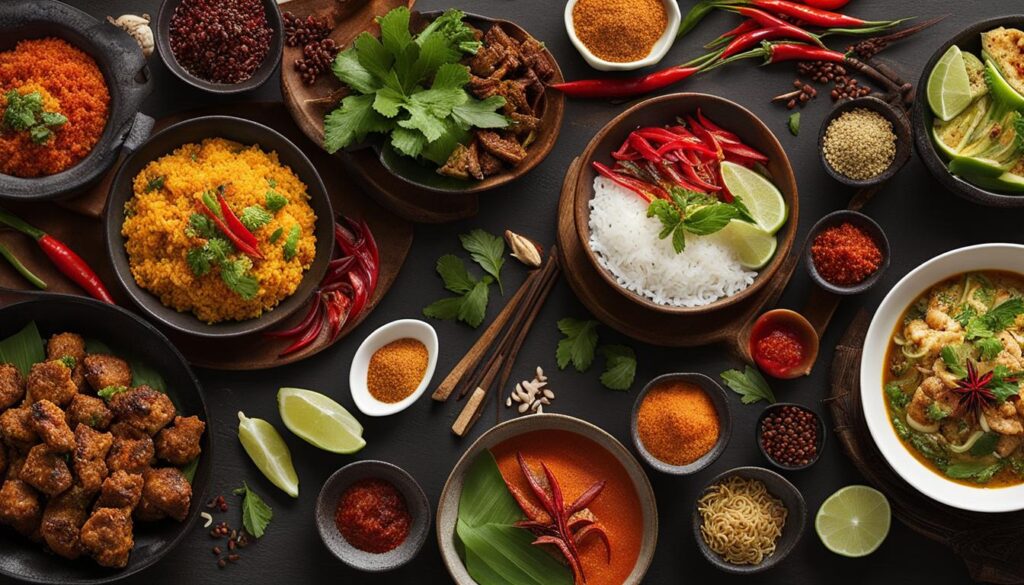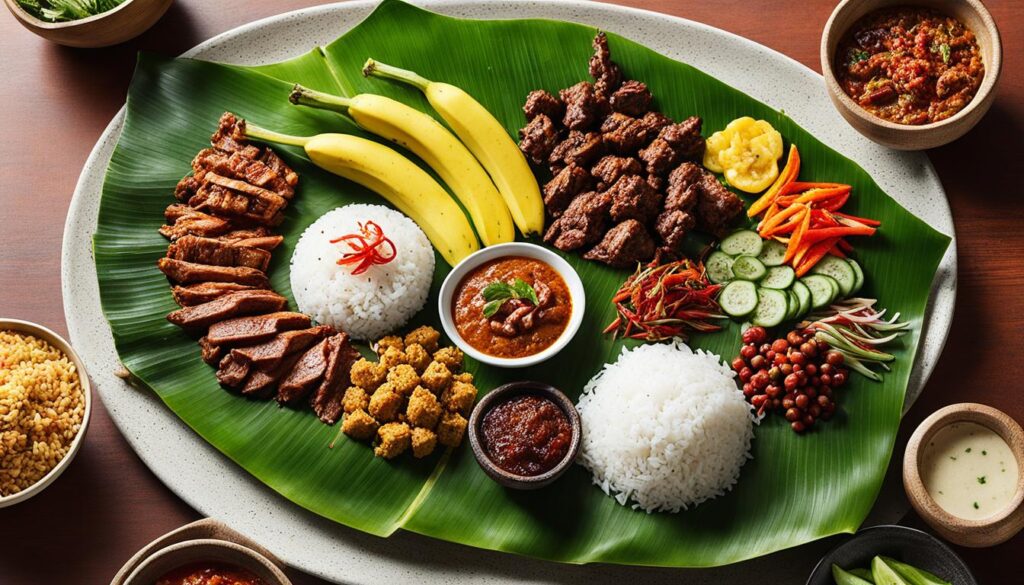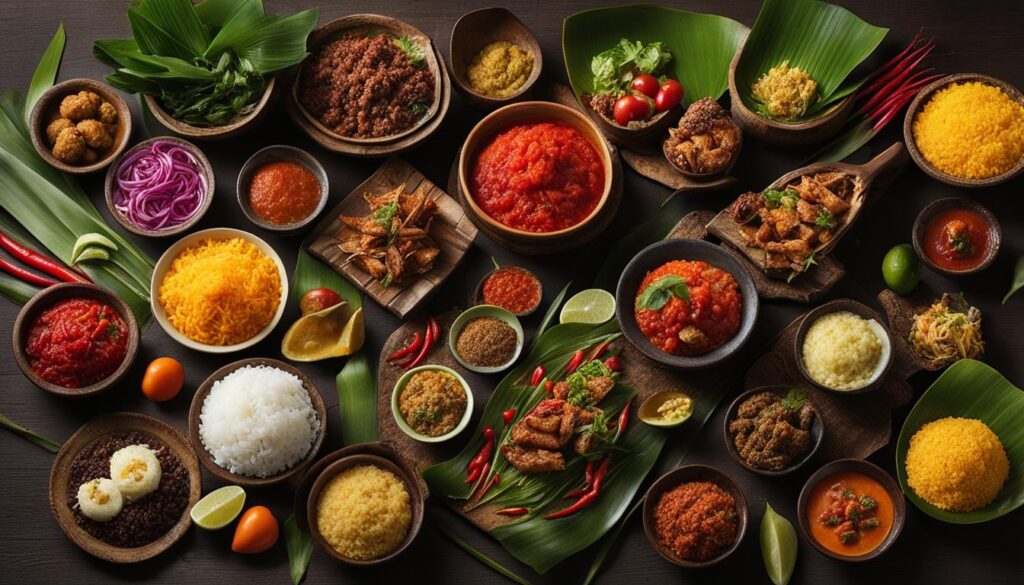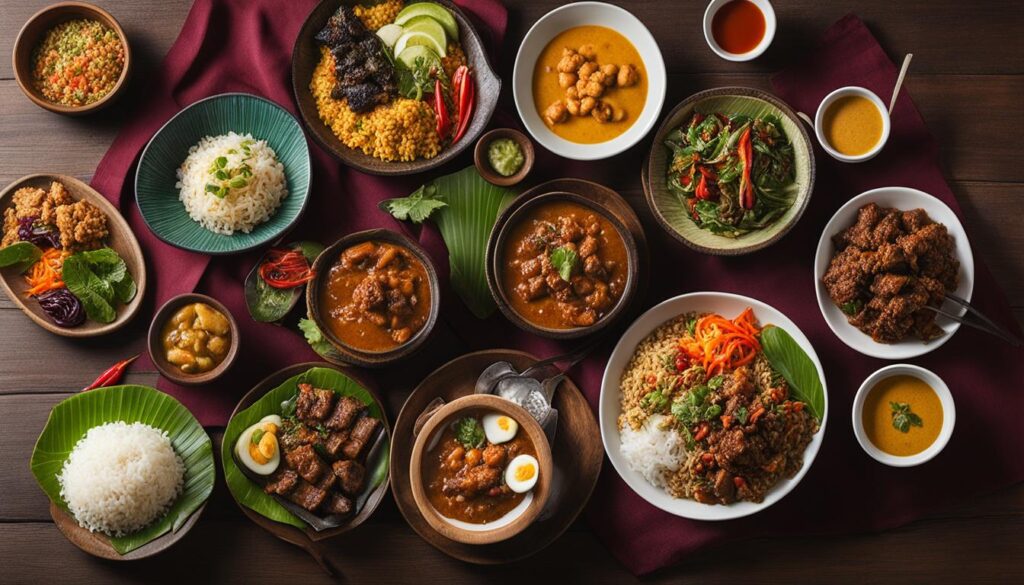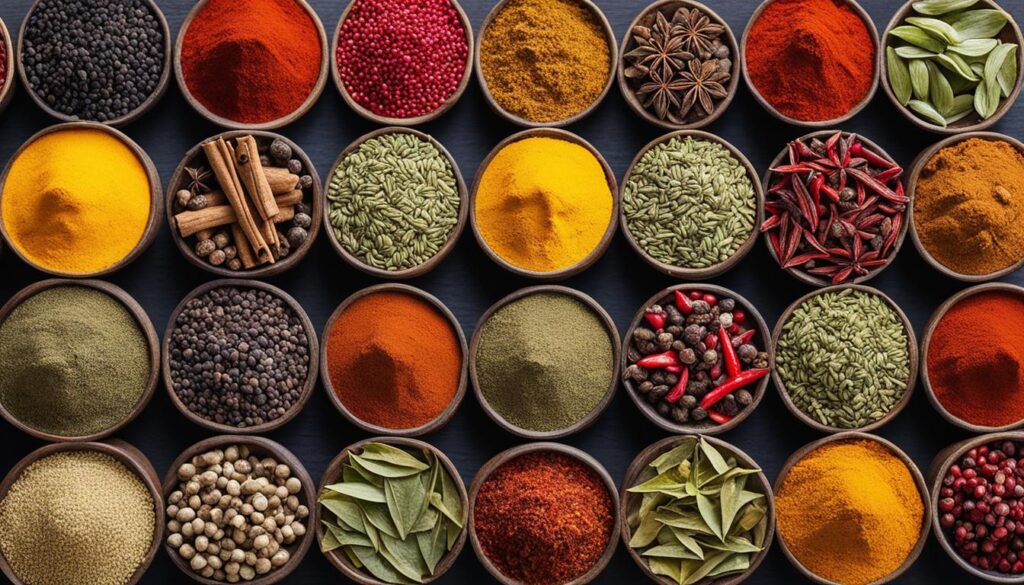Are you tired of always ordering the same old Indonesian dishes like nasi goreng and rendang? Do you want to explore the best authentic Indonesian cuisine beyond these staples? Look no further! In this article, we will take you on a culinary journey, unraveling the rich flavors and hidden gems of traditional Indonesian dishes. From aromatic Indonesian spices to lesser-known Indonesian recipes, we’ve got you covered. So let’s dive into the mouthwatering world of Indonesian food and discover its diverse culinary heritage.
The Essence of Indonesian Cuisine: A Fusion of Flavors
Indonesian cuisine is a true melting pot of different influences from around the world, which has contributed to its diversity and richness in flavors. From the aromatic spices utilized in Indian and Middle Eastern cuisine to the fresh seafood found in coastal regions, Indonesian dishes are a reflection of the country’s diverse cultural history.
In Indonesian cuisine, the ingredients and flavors are often combined in unexpected and delightful ways, resulting in a unique gastronomic experience that is hard to replicate. This delicious fusion of flavors is what sets Indonesian cuisine apart from other Asian cuisines and makes it a must-try for food enthusiasts.
The combination of flavors in Indonesian cuisine is like a symphony. Every ingredient is carefully selected, mixed with other ingredients, and cooked to perfection, resulting in a harmonious blend of flavors and textures.
Indonesian cuisine is also heavily influenced by the country’s geography, with the various regions of Indonesia boasting their own unique specialties. From the spicy and flavorful dishes of Padang cuisine to the sweet and aromatic flavors of Balinese cuisine, the diversity of Indonesian cuisine is truly remarkable.
Exploring Traditional Indonesian Dishes
Indonesia’s cuisine is a rich tapestry of traditional dishes that showcases the country’s cultural heritage and diverse influences. From the sweet and spicy flavors of the famous gado-gado to the tangy and aromatic notes of the hearty soto ayam, traditional Indonesian dishes are a gastronomic adventure.
Gado-Gado
If you’re looking to try one of Indonesia’s most famous dishes, look no further than gado-gado. This traditional salad is a colorful mix of blanched vegetables, tofu, tempeh, and lontong (rice cakes), all smothered in a delicious peanut sauce. The dish is usually served with a side of krupuk (crackers) and is perfect for a light lunch or dinner.
Soto Ayam
Soto ayam is a comforting chicken soup that’s popular across Indonesia. The broth is flavored with lemongrass, galangal, and turmeric, giving it a tangy and aromatic flavor. The soup is typically served with shredded chicken, vermicelli noodles, and a boiled egg. Squeeze a wedge of lime over the soup for an extra punch of flavor.
Rendang
While rendang may be a bit more well-known than some of the other dishes on this list, it’s worth mentioning as a must-try Indonesian dish. This slow-cooked beef stew is bursting with flavor, thanks to a mix of spices (including turmeric, galangal, and lemongrass), coconut milk, and tamarind. The result is a tender and aromatic dish that’s perfect for any occasion.
You can’t go wrong with any of these traditional Indonesian dishes. They’re packed with flavor and are a great way to experience the rich culinary heritage of Indonesia.
Unveiling Indonesian Regional Specialties
As we explore the best authentic Indonesian cuisine, it’s essential to examine the regional specialties that highlight the diverse culinary traditions of Indonesia’s different regions. Each region has its unique flavors and dishes, providing a full range of gastronomic experiences.
Bali
Bali’s flavorful cuisine is heavily influenced by Chinese and Indian cuisines, with the addition of local produce. The use of aromatic ingredients and flavorful spices is typical of Balinese dishes. Some top regional specialties from Bali include:
| Dish | Description |
|---|---|
| Babi Guling | A roasted pig dish, served with a spicy sauce and rice. |
| Nasi Campur | A rice dish with assorted toppings, typically consisting of meats, vegetables, and spice blends. |
| Lawar | A dish of chopped vegetables, meat, and coconut, seasoned with Balinese spices and condiments. |
Padang
Padang cuisine originates from West Sumatra, and its dishes are known for their spicy flavors and use of coconut milk. Mentawai Island, located off Sumatra’s coast, features a popular food culture focused on traditional cooking techniques and dishes. Some of Padang’s most well-known regional specialties include:
| Dish | Description |
|---|---|
| Rendang | A meat curry dish flavored with spice paste, coconut milk, and herbs, often served with rice. |
| Sate Padang | Skewered and grilled meat served with a spicy sauce made with chili, turmeric, and other spices. |
| Paru Belado | A beef lungs dish with fiery chili sauce, served with steam rice and side dishes |
North Sulawesi
North Sulawesi cuisine is famous for its seafood-based dishes and bold use of spices. These flavors come from the Minahasa people, who hail from the region. The proximity of North Sulawesi to the Philippines also has an influence on its food culture. Some of the region’s top specialties include:
| Dish | Description |
|---|---|
| Cakalang Fufu | A smoked tuna fish dish mixed with spicy sauce, cassava dumpling, and corn. |
| Udang Woku | A prawn dish cooked in an aromatic herbal and spice mixture with tomato and lemongrass flavors. |
| Tinutuan | A breakfast porridge from corn, pumpkin, cassava leaves, lemongrass, and pumpkin flower |
Don’t miss your chance to experience the unique flavors of Indonesia’s regional specialties! Whether you’re a fan of spicy Padang cuisine or prefer the aromatic dishes of Bali, there’s something for every palate in Indonesia.
Exploring Lesser-Known Indonesian Recipes
If you are looking for something out of the ordinary, Indonesia is the perfect destination for your taste buds. Besides the famous nasi goreng and rendang, lesser-known Indonesian recipes are waiting to be discovered. Whether it’s the savory flavors of nasi liwet or the grilled fish of ikan bakar, Indonesian cuisine has some hidden gems that might surprise you.
To help you explore the culinary world of Indonesia, we’ve put together a list of some lesser-known Indonesian recipes that are worth trying. Take a look below:
1. Nasi Liwet
Nasi liwet is a traditional rice dish from Central Java. Cooked with coconut milk, bay leaves, and other spices, it has a rich flavor and is usually served with chicken or egg. This dish is perfect for those who love creamy and flavorful rice dishes.
2. Ikan Bakar
Ikan bakar is a grilled fish dish that’s popular in coastal areas of Indonesia. The fish is marinated in spices and then grilled over charcoal. It’s usually served with sambal, a chili sauce, and is perfect for those who love spicy seafood.
3. Sate Maranggi
Sate Maranggi is a type of satay from Purwakarta, West Java, that’s made with beef and a unique spice blend. The meat is skewered and grilled over charcoal until aromatic and slightly charred on the outside. It’s usually served with peanut sauce and sliced onions. This dish is perfect for meat lovers who enjoy a blend of sweet and savory flavors.
4. Opor Ayam
Opor ayam is a chicken dish that’s cooked in coconut milk and spices. It’s usually served with lontong, a compressed rice cake, and is commonly found on the table during special occasions like Eid al-Fitr. This dish is perfect for those who love flavorful and aromatic chicken dishes.
5. Soto Betawi
Soto Betawi is a beef soup that’s originated from Jakarta. The soup is flavored with spices, coconut milk, and beef broth and is usually served with rice cakes, beansprouts, and boiled egg. This dish is perfect for those who love hearty and comforting soups.
“Indonesian cuisine offers not only the famous dishes but also lesser-known recipes that are worth exploring. From savory rice dishes like nasi liwet to hearty soups like soto betawi, Indonesian cuisine is a treasure trove of flavors that can surprise even the most adventurous palates.”
The Rise of Indonesian Restaurants
Indonesian cuisine is gaining ground in the United States, and it shows no signs of slowing down. Whether you’re a fan of classic rice dishes or spicy meat curries, there are plenty of Indonesian restaurants to choose from. From coast to coast, you’ll discover a range of establishments, from humble roadside stands to upscale eateries that expertly blend Indonesian flavors with other global influences.
At the forefront of this trend is Warung Selasa, a family-run establishment in Brooklyn, New York that serves up some of the best Indonesian cuisine in the city. Here you can indulge in classic dishes like nasi campur and mie goreng, or branch out and try something new like tahu goreng or lumpia.
| Restaurant Name | Location |
|---|---|
| Java Indonesian Cuisine | Los Angeles, CA |
| Indo | St. Louis, MO |
| Bali Kitchen | New York, NY |
| Nusantara | Seattle, WA |
For those looking to explore Indonesian cuisine further, Indo Eats is a delivery service that brings a taste of Indonesia right to your doorstep. Their menu features classic dishes like rendang and satay, as well as lesser-known specialties like tahu telur and gado-gado.
Indonesian Spices: The Secret to Flavorful Dishes
You can’t talk about Indonesian cuisine without mentioning the rich and aromatic spices that are the heart and soul of many Indonesian dishes. These spices are responsible for the depth and complexity of the flavors that Indonesian cuisine is known for.
Some of the most commonly used Indonesian spices include:
| Spice | Flavor Profile |
|---|---|
| Bumbu | A blend of spices including galangal, turmeric, and lemongrass. Used in many Indonesian dishes, especially curries. |
| Kencur | A type of ginger used in many Indonesian soups and stews. |
| Kaffir lime leaves | These fragrant leaves add a citrusy flavor to many Indonesian dishes, including soups, stews, and curries. They’re typically added whole and removed before serving. |
| Candlenuts | Similar in flavor to macadamia nuts, candlenuts are often used to thicken sauces and stews in Indonesian cuisine. |
Indonesian spices are not only known for their unique flavors but also their health benefits. For example, turmeric, a key ingredient in many Indonesian spice blends, is known for its anti-inflammatory properties and is used in traditional medicine to treat a variety of ailments.
If you’re looking to incorporate Indonesian spices into your own cooking, start by experimenting with bumbu, the ubiquitous Indonesian spice blend. You can use it as a base for curries, stir-fries, and marinades. Or try adding kaffir lime leaves to soups or stews to add a bright, citrusy flavor.
“Indonesian spices are what make Indonesian cuisine stand out from other Asian cuisines. Without the mix of spices, the flavors will be completely different. ” – William Wongso
Traditional Indonesian Street Food: A Culinary Adventure
When visiting Indonesia, you can’t miss out on the exciting street food scene. From savory to sweet, there’s something for everyone to enjoy. Here are a few traditional Indonesian street foods you need to try:
Nasi Goreng
This quintessential Indonesian dish is a must-try on the street food scene. It’s a fried rice dish made with soy sauce, shrimp paste, and chili, and is often served with a fried egg, sliced cucumber, and crunchy kerupuk (Indonesian crackers).
Satay
Indonesian satay skewers are a popular street food, and for good reason! Marinated meat or tofu is skewered and grilled over an open flame, then served with a sweet and savory peanut sauce for dipping.
Martabak
If you have a sweet tooth, you’ll love martabak. This is a thick, fluffy pancake stuffed with a variety of fillings, such as chocolate, cheese, nuts, and condensed milk. It’s often served as a dessert, but you can also find savory options filled with meat or vegetables.
These are just a few examples of the delicious traditional Indonesian street food waiting to be discovered. Be adventurous and try as many as you can – you won’t regret it!
Modern Innovations in Indonesian Cuisine
Indonesian cuisine is going through a period of innovation and transformation, with chefs and culinary enthusiasts introducing new techniques, flavors, and presentations to traditional dishes. These modern innovations are redefining Indonesian cuisine and bringing it to new heights in the culinary world.
One of the most significant changes in Indonesian cuisine is the fusion of traditional techniques with contemporary recipes and ingredients. For example, the famous dish of nasi goreng, which typically includes rice, eggs, and spices, is being reinvented with the addition of unique ingredients such as quinoa and kale, to make it more nutritious.
Another modern innovation is the use of unconventional cooking methods, such as molecular gastronomy. In Bali, Chef Mandif Warokka is known for his molecular gastronomy restaurant, where traditional dishes are transformed into unique creations, such as sate lilit made with foie gras and a mango-lime foam.
The use of Indonesian spices and herbs is also being explored in new and exciting ways. Chefs are experimenting with different spice blends to create unique flavor combinations, and even incorporating Indonesian flavors into Western dishes.
“I believe that Indonesian cuisine is still evolving and has the potential to become a major player in the world’s culinary map. The combination of unique spices and herbs, diverse recipes and cooking techniques make Indonesian cuisine an exciting territory for culinary innovators to explore.”
The modern innovations in Indonesian cuisine are giving us new and exciting ways to experience this rich culinary heritage. Whether you’re a traditionalist or an adventurous foodie, you’ll find something to love in these culinary reimaginings.
Embracing Indonesian Culinary Heritage at Home
Now that you’ve experienced the rich and diverse flavors of authentic Indonesian cuisine, why not recreate them in your own kitchen? Incorporating Indonesian culinary heritage into your home cooking is a great way to expand your palate and impress your friends and family. Here are a few tips to get you started:
1. Source Authentic Ingredients
The key to creating authentic Indonesian dishes is using the right ingredients. Look for specialty stores that carry Indonesian spices, sauces, and other ingredients, or order them online. Some must-have ingredients include kecap manis (sweet soy sauce), sambal oelek (chili paste), and tamarind paste.
2. Learn Traditional Cooking Techniques
Learning traditional Indonesian cooking techniques can take your dishes to the next level. For example, rendang, a popular Indonesian dish, is cooked for several hours to allow the meat to absorb all the flavors of the spices. Nasi goreng, on the other hand, is best made with day-old cooked rice to achieve the perfect texture.
3. Experiment with Indonesian Recipes
There are countless Indonesian recipes waiting to be explored. Start with the classics, like nasi goreng and rendang, and then branch out to lesser-known dishes like sate lilit (Balinese fish skewers) and lumpia (spring rolls). Don’t be afraid to experiment and put your own spin on the recipes.
4. Share Your Creations with Others
Food is best enjoyed with others, so why not share your Indonesian creations with friends and family? Host an Indonesian-themed dinner party or bring a dish to your next potluck. Sharing your love of Indonesian cuisine is a great way to spread the word and create new fans.
“Indonesian cuisine is a beautiful expression of the country’s rich culture and history. Embracing it at home is a wonderful way to appreciate and honor that heritage.”
By following these tips, you can bring the magic of Indonesian culinary heritage into your own home. Get creative, have fun, and enjoy the delicious flavors of Indonesia!
Conclusion
Congratulations, you’ve reached the end of our article on discovering authentic Indonesian dishes beyond the basics! We hope this culinary journey has inspired you to explore the rich flavors and traditions of Indonesian cuisine.
From the fusion of flavors that define Indonesian dishes to the diverse regional specialties and lesser-known recipes waiting to be discovered, there’s a world of Indonesian cuisine beyond nasi goreng and rendang.
Whether you’re looking to experience Indonesian food in a restaurant or want to try your hand at cooking traditional dishes at home, we’ve provided insights and tips for embracing Indonesian culinary heritage.
So, what are you waiting for? Start exploring the delights of Indonesian cuisine today!






























